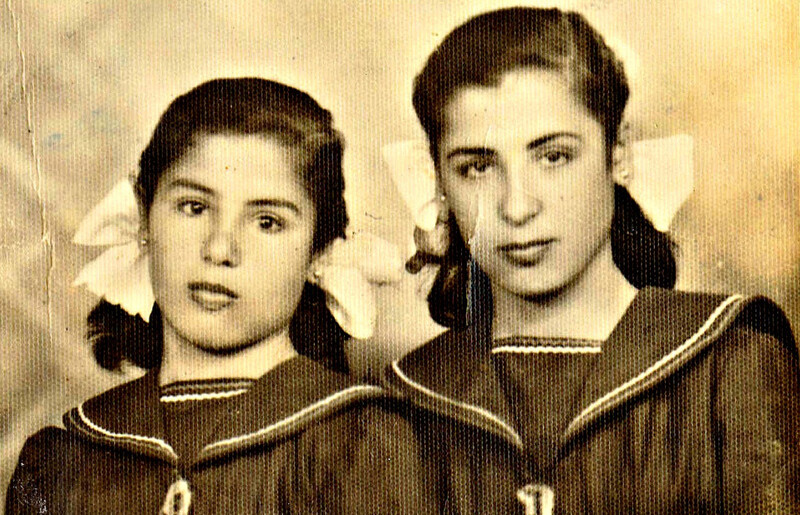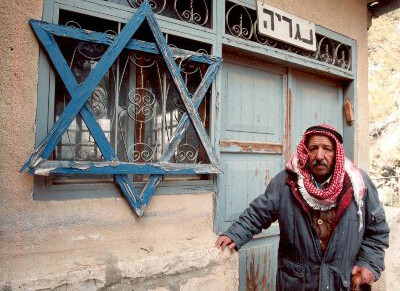The Electronic Intifada Chicago 8 April 2013

The author’s grandmother, Fatima Radwan (right) and her younger sister Sakeena at the Dar al-Tifl school four years after the Deir Yassin massacre.
Transcribing the vivid details of the account engraved into the fabric of her memory, I am transfixed by all that she’s held onto for 65 years. From paper to pulse, I write the story buried deep in her consciousness to affirm her truth. Without her, it never would be written at all.
I study the lines on my grandmother’s face knowing behind every one there is a timeless story of unmitigated pain, survival and hope. This story, where the continued dispossession, suffering and oppression of the Palestinian people began, is one that refuses to be silenced or forgotten. It is the story of Deir Yassin.
Remember the date: Friday, 9 April 1948, a day of infamy in Palestinian history. My grandmother was nine years old at the time of the Deir Yassin massacre and every day since she has lived with a steadfast commitment to never forget.
Premonition
Thursday, 8 April, ended like any other in the small, quiet village. My grandmother and her younger sister returned home from school to complete their composition assignment entitled Asri’ (meaning “to hurry” in Arabic). She recounts that detail animatedly. Like other children their age, she wanted to complete the assignment in order to enjoy the next day off.
The excitement, however, was short-lived. I can’t help but think of the irony in the assignment’s title. Asri’ — it’s almost as though it were a premonition of sorts.
The following day, entire families ran hurriedly in sheer terror, fleeing the only homes they had ever known to escape a bloodbath. By dawn on that Friday morning, life as they had known it would never be the same again. Deir Yassin would never be the same again.
Fathers, grandfathers, brothers and sons were lined up against a wall and sprayed with bullets, execution style. Beloved teachers were savagely mutilated with knives. Mothers and sisters were taken hostage and those who survived returned to find pools of blood filling the streets of the village and children stripped of their childhoods overnight.
The walls of homes, which once stood witness to warmth, laughter and joy, were splattered with the blood and imprints of traumatic memories. My grandmother lost 37 members of her family that day. These are not stories you will read about in most history books.
Bitter symbol
The Deir Yassin massacre was not the largest-scale massacre, nor was it the most gruesome. The atrocities committed, the scale of violence and the complexity of the methods and insidious weaponry used by Israel against civilians in the recent decade have been far more sadistic and pernicious. But Deir Yassin marks one of the most critical turning points in Palestinian history.
A bitter symbol carved in the fiber of the Palestinian being and narrative, it resonates sharply as the event that catalyzed our ongoing Nakba (catastrophe), marked by the forced exile of 750,000 Palestinians from their homes, creating the largest refugee population worldwide with more than half living in the diaspora.
Deir Yassin is a caustic reminder of the ongoing suffering, struggle and systematic genocide of the Palestinian people, 65 years and counting. When the village was terrorized into fleeing, tumultuous shockwaves of terror ran through Palestine, laying the blueprint for the architecture of today’s apartheid Israel.
Sacred ground

The author’s great-uncle, Muhammad Radwan, outside of the family home in Deir Yassin.
I have been fortunate enough to see Deir Yassin and step foot on its sacred ground. Deir Yassin remains a permanently cemented and rigorous reminder of the spirit that has never permitted defeat. Despite the illegal settlements, pillaging, plundering and human suffering that took place, my grandmother’s home stands with resolve just as she does today.
The silence of her home and the original stones laid by my great-grandfather’s hands remain haunting reminders of life that once existed behind the cold facade. Standing outside her home I studied the horizon intently and found solace, irrespective of the large wooden Star of David hanging on the window. This scathing and unholy reminder of the ethnic cleansing that took place there could never conceal the insult, injury and history it attempts to erase.
In fact, it is a reminder of the inflicted wounds that remain open and the memory that remains very much alive. All the flags, banners and stars in the world, all the inconvenient truths, dehumanizing myths of exceptionalism and litany of crimes, will never succeed in drowning out the truth or erasing the memories.
My grandmother is an intrepid survivor and living proof that neither the old nor the young will forget. She and survivors like her endure with a steadfastness that will live long after they’re gone. Their narratives may not be recorded in our history books but they have left indelible impressions that will remain inscribed in our hearts and minds.
The narratives of these survivors will continue to run through the veins of every Palestinian child who carries them in their blood. And so long as our hearts beat, the eloquent symbols of Palestinian life — resistance, resilience and hope — will continue to run strong. No amount of fear-mongering, lip service or pontificating will ever keep these narratives of resistance from circulating, because becoming comfortable with our own silence and anesthetizing our minds to all that has passed will never be options.
After all, we are the children of generations of strength. Our grandparents and parents are refugees and survivors, and the blood of Deir Yassin courses through our veins. We are like the olive tree with its tenacious roots in the ground, remaining unshakable and determined to stand its ground with patience and a deeply-rooted desire to remain.
We will see a free and just Palestine because we will have a hand in making it so. Deir Yassin may have catalyzed our catastrophe but 65 years later it also continues to catalyze our devotion and enduring love for a people, a cause and a home that will never be relinquished or forgotten.
All images courtesy of Dina Elmuti.
Dina Elmuti is a social worker researching the impacts of chronic traumatic stress and violence on the physical, mental and psychosocial health of children in Chicago and Palestine.





